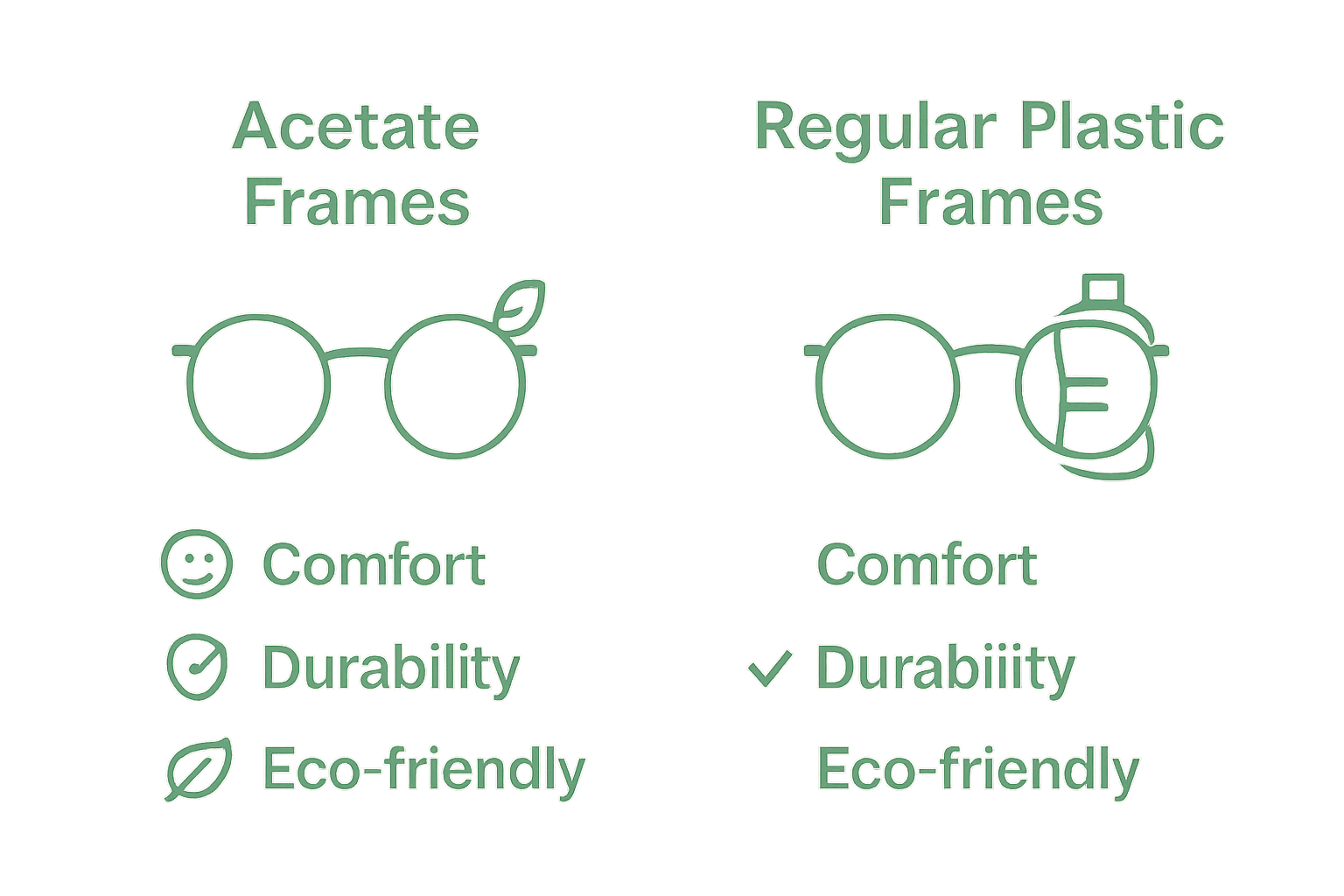
Understanding Why Acetate Frames Are a Smart Choice
Acetate frames have changed the way Aussies think about their glasses. Most people never realise their eyewear could come from wood pulp and cotton, not just plastic. And even more surprising is that acetate frames are hypoallergenic and kinder to sensitive skin, plus they can be made in nearly endless colours and patterns. Suddenly, choosing new specs is not just about seeing better, but about wearing comfort, durability, and even helping the planet at the same time.
Table of Contents
- What Are Acetate Frames And Their Composition?
- Why Do Acetate Frames Matter For Eyewear Choices?
- How Acetate Frames Offer Comfort And Durability
- Key Features Of Acetate Frames: Style And Versatility
- Environmental Considerations Of Acetate Frames
Quick Summary
| Takeaway | Explanation |
|---|---|
| Acetate frames are hypoallergenic. | They are made from natural cellulose, making them suitable for individuals with sensitive skin or allergies. |
| Acetate offers diverse design options. | This material allows for a wide range of colours, patterns, and textures, enabling personal style expression through eyewear. |
| Durability surpasses traditional frames. | Acetate frames are resistant to temperature changes and impact, ensuring long-lasting performance and structural integrity. |
| Sustainable and eco-friendly choice. | Made from renewable resources, acetate reduces environmental impact compared to petroleum-based plastics, supporting responsible consumption. |
| Innovative ergonomic design. | Acetate frames adapt to body temperature, providing a custom-like fit that enhances wearing comfort during extended use. |
What Are Acetate Frames and Their Composition?
Acetate frames represent a sophisticated approach to eyewear design, offering a unique blend of aesthetics and functionality. Cellulose acetate, the primary material used in these frames, transforms traditional eyewear manufacturing through its remarkable properties and sustainable origins.
The Natural Origins of Acetate
Unlike conventional plastic frames, acetate emerges from natural materials including wood pulp and cotton fibers. This plant-based composition creates a hypoallergenic material that provides exceptional comfort for wearers. The manufacturing process involves carefully transforming cellulose into a malleable, durable plastic that can be precisely shaped into elegant frame designs. Read more about our guide on reading glasses frame materials to understand how different materials impact eyewear performance.
The molecular structure of cellulose acetate allows for remarkable flexibility and strength. Manufacturers can produce frames in an extensive range of colours and patterns, making acetate an incredibly versatile material. The production involves several intricate steps:
- Chemical treatment of raw cellulose fibers
- Conversion into a moldable polymer
- Precision cutting and shaping of frame components
- Careful polishing and finishing
Performance and Design Characteristics
Acetate frames distinguish themselves through several key performance attributes. Their lightweight nature ensures comfortable wear, while the material’s inherent strength provides durability that surpasses traditional frame materials. The frames resist temperature variations and maintain their structural integrity across different environmental conditions.
The aesthetic versatility of acetate allows for bold colour expressions and intricate design possibilities. Artisan eyewear makers appreciate acetate for its ability to be crafted into complex shapes and patterns, enabling truly unique frame designs that reflect individual style and personality. Each acetate frame becomes not just a functional accessory, but a personal statement of design and craftsmanship.

Moreover, acetate’s hypoallergenic properties make it an excellent choice for individuals with sensitive skin or allergies to metal-based frame materials. Its smooth surface and ability to be manufactured without harsh chemicals contribute to its growing popularity among discerning eyewear consumers seeking both performance and responsible material choices.
Why Do Acetate Frames Matter for Eyewear Choices?
Choosing the right eyewear involves more than aesthetic preferences. Acetate frames represent a significant evolution in frame technology, offering substantial advantages that transform how people approach their vision correction and personal style. Explore our comprehensive guide to reading glasses frame styles to understand the nuanced world of eyewear selection.
Comfort and Personalisation
Acetate frames excel in delivering unparalleled wearing comfort. Their lightweight composition ensures minimal pressure on the nose bridge and temples, reducing fatigue during extended wear. Unlike metal frames that can cause skin irritation, acetate provides a gentle, hypoallergenic alternative suitable for individuals with sensitive skin. The material adapts to body temperature, creating a seamless fit that feels almost invisible.
The personalisation potential of acetate frames stands out as another critical advantage. Manufacturers can produce frames in an extraordinary spectrum of colours, patterns, and textures. This versatility allows wearers to express their individual style through their eyewear, transforming glasses from a functional necessity into a fashion statement.
Performance and Durability Considerations
The performance characteristics of acetate frames set them apart from traditional materials. These frames demonstrate remarkable resilience across various environmental conditions. Key performance attributes include:
- Enhanced resistance to temperature fluctuations
- Superior impact resistance compared to traditional plastic frames
- Minimal colour fading over extended periods
- Ability to maintain structural integrity under regular use
Moreover, acetate’s molecular structure contributes to its exceptional durability. The material resists cracking and breaking, providing a long-lasting eyewear solution that represents a wise investment for discerning consumers. Professional eyewear makers appreciate acetate for its precision manufacturing capabilities, enabling intricate designs that were previously impossible with other frame materials.
Beyond technical specifications, acetate frames represent a commitment to sustainable and responsible manufacturing. Derived from natural cellulose materials, these frames offer an environmentally conscious alternative to petroleum-based plastics. For individuals seeking eyewear that combines performance, style, and ecological responsibility, acetate frames emerge as an intelligent and forward-thinking choice.
Below is a comparison of acetate frames with traditional metal and plastic frames to help clarify their advantages as highlighted in the article.
| Feature | Acetate Frames | Traditional Plastic Frames | Metal Frames |
|---|---|---|---|
| Material Source | Plant-based (wood pulp, cotton fibres) | Petroleum-based | Metal alloys (e.g., nickel, titanium) |
| Hypoallergenic | Yes | Often No | Rarely* |
| Comfort & Fit | Lightweight, adapts to body temperature | Can be heavier, less adaptable | May cause pressure points |
| Durability | High impact & temperature resistance | Prone to cracking/brittleness | Can bend/break, may corrode |
| Design Versatility | Wide range of colours, patterns, shapes | Limited colour and design options | Limited to metallic finishes |
| Environmental Consideration | Renewable and recyclable | Non-renewable, less recyclable | Varies, often not sustainable |
| Suitability for Sensitive Skin | Excellent | Sometimes causes irritation | May cause allergic reactions |
*Some specialised metals (e.g., titanium) are hypoallergenic, but most everyday metal frames may contain nickel which can cause reactions.
How Acetate Frames Offer Comfort and Durability
The intersection of comfort and durability defines the exceptional quality of acetate frames. Innovative material engineering transforms eyewear from a simple vision correction tool into a sophisticated accessory that prioritises wearer experience. Learn why acetate reading glasses are the best choice to understand their unique advantages.
Ergonomic Design and Material Properties
Acetate frames excel in creating a seamless wearing experience through their remarkable ergonomic characteristics. The material’s inherent flexibility allows precise adjustments that conform to individual facial structures, eliminating pressure points and reducing discomfort. Unlike rigid metal frames, acetate distributes weight evenly across the nose bridge and temples, minimising fatigue during prolonged wear.
The thermal adaptability of acetate represents another crucial comfort factor. This material responds subtly to body temperature, softening and molding slightly to create an almost custom-like fit. Wearers experience a sensation of lightness and natural integration, transforming glasses from an external accessory to an extension of personal comfort.
Structural Resilience and Long-Term Performance
Durability stands as a hallmark of acetate frame construction. The molecular structure of cellulose acetate provides exceptional strength and resistance to environmental challenges. Key performance characteristics include:
- Superior impact resistance compared to traditional plastic frames
- Minimal degradation from sunlight and temperature variations
- Resistance to chemical interactions and surface scratching
- Maintained structural integrity through extended use
Professional eyewear manufacturers appreciate acetate for its precision manufacturing capabilities. The material allows for intricate design details and complex geometric shapes that would be challenging or impossible with alternative frame materials. This versatility ensures that durability does not compromise aesthetic expression.
Moreover, acetate’s resilience translates into long-term economic value. Frames crafted from this material demonstrate remarkable longevity, resisting common forms of wear and tear that typically compromise less sophisticated eyewear.
Here is a summary of the key benefits of acetate frames, capturing core features and the value they offer as discussed across the article.
| Key Feature | Description |
|---|---|
| Hypoallergenic Material | Minimises skin irritation, suitable for sensitive skin and allergy-prone |
| Eco-friendly Origins | Made from wood pulp and cotton fibres, offering a renewable alternative |
| Broad Design Options | Wide selection of colours, patterns, and finishes for personal expression |
| Lightweight & Comfortable | Reduces fatigue with minimal pressure on nose bridge and temples |
| Durable Structure | Withstands temperature shifts, impact, and daily wear with minimal fading |
| Ergonomic Adaptability | Conforms subtly to body temperature, ensuring a custom-like fit |
| Recyclability | Can be repurposed after use, supporting sustainable consumption |
Key Features of Acetate Frames: Style and Versatility
Acetate frames transcend traditional eyewear design, offering a remarkable fusion of aesthetic innovation and functional sophistication. The material represents more than just a frame choice. Explore our selection of vintage frame styles to appreciate the transformative potential of eyewear design.
Aesthetic Diversity and Colour Expression
The extraordinary visual versatility of acetate frames sets them apart in the eyewear landscape. Unlike metal or conventional plastic frames, acetate enables manufacturers to create an expansive palette of colours, patterns, and textures. This material can be seamlessly laminated, creating multi-layered visual effects that capture light and personal style with unprecedented complexity.
Professional designers leverage acetate’s unique properties to craft frames that are truly wearable art. The material allows for intricate marbling techniques, translucent colour gradients, and rich, deep pigmentations that remain vibrant over time. Wearers can select frames that complement their skin tone, personal aesthetic, and wardrobe, transforming eyewear from a functional necessity to a personal style statement.
Manufacturing Flexibility and Design Innovation
Acetate’s manufacturing capabilities represent a quantum leap in frame production. The material’s inherent plasticity enables designers to experiment with complex geometric shapes and structural innovations that were previously impossible. Key design advantages include:
- Ability to create seamless, fluid frame contours
- Enhanced potential for intricate surface treatments
- Capacity to integrate multiple visual textures within a single frame
- Precision in creating lightweight, ergonomic designs
The molecular structure of acetate allows for unprecedented manufacturing precision. Eyewear makers can produce frames with microscopic variations in thickness and curvature, ensuring optimal fit and comfort. This level of design sophistication means each pair of acetate frames can be subtly customised to individual facial structures and aesthetic preferences.
Ultimately, acetate frames represent a harmonious intersection of technological innovation and personal expression. They offer wearers an opportunity to communicate individuality through an accessory that balances functional requirements with aesthetic ambition. For those seeking eyewear that tells a story, reflects personality, and provides exceptional visual comfort, acetate frames emerge as an unparalleled choice.
Environmental Considerations of Acetate Frames
Sustainable eyewear manufacturing represents a critical evolution in material science and environmental responsibility. Acetate frames emerge as a progressive solution addressing ecological concerns while delivering exceptional performance. Discover our commitment to sustainable reading glasses to understand the broader implications of responsible material choices.
Natural Material Origins
Cellulose acetate distinguishes itself through its remarkable ecological foundation. Derived from renewable plant sources like wood pulp and cotton fibres, this material represents a significant departure from petroleum-based plastics. The manufacturing process transforms natural cellulose into a durable, adaptable polymer without exhausting non-renewable resources.
The production of acetate frames involves substantially lower environmental impact compared to traditional frame materials. By utilising plant-based components, manufacturers reduce carbon emissions and minimise dependence on fossil fuel derivatives.
 This approach transforms eyewear from a purely functional accessory into a conscientious consumer choice that supports broader environmental sustainability goals.
This approach transforms eyewear from a purely functional accessory into a conscientious consumer choice that supports broader environmental sustainability goals.
Recyclability and Waste Reduction
Acetate’s potential for recycling and responsible disposal represents another crucial environmental advantage. Unlike many synthetic plastics that persist in landfills, cellulose acetate can be processed and repurposed through specialised recycling streams. Key environmental benefits include:
- Potential for mechanical recycling without significant material degradation
- Reduced long-term waste accumulation compared to traditional plastics
- Lower energy requirements during reprocessing
- Capacity to create secondary products from recycled frame materials
Manufacturers and environmental experts recognise acetate as a progressive material that bridges performance requirements with ecological consciousness. The molecular structure allows for multiple recycling cycles, ensuring that discarded frames do not become permanent waste contributors.
Ultimately, choosing acetate frames represents more than a personal style decision. It signifies a commitment to supporting sustainable manufacturing practices, reducing environmental impact, and participating in a broader movement towards responsible consumption. For environmentally conscious consumers, acetate frames offer a tangible way to make a positive ecological choice without compromising on quality, durability, or aesthetic appeal.
Upgrade Your Everyday Style with Acetate Reading Glasses
Are you tired of uncomfortable or uninspired eyewear that does not meet your expectations for comfort, durability, or design? The article highlighted how acetate frames solve common pain points, like irritation from traditional plastics and limited style options. Discover the benefits of acetate for yourself in our curated collection of Geometric Reading Glasses, which showcase the strength, colour depth, and all-day comfort featured in the latest innovations discussed above.

Elevate your look and experience the difference with high-quality reading glasses that do more than aid your vision. Browse our full range at Ministry of Sight and find frames that truly reflect your personality and values. Shop now for durable, stylish acetate designs and enjoy eyewear built to last.
Frequently Asked Questions
What are acetate frames made of?
Acetate frames are primarily made from cellulose acetate, a material derived from natural sources like wood pulp and cotton fibres. This makes them a hypoallergenic and comfortable alternative to conventional plastic frames.
Why are acetate frames considered durable?
Acetate frames exhibit exceptional durability due to their molecular structure, which provides superior impact resistance and minimal degradation from environmental factors, making them a long-lasting eyewear option.
How do acetate frames offer comfort for wearers?
Acetate frames are lightweight and can adapt to body temperature, creating a seamless fit that distributes weight evenly across the nose bridge and temples, ensuring maximum comfort during extended wear.
What makes acetate frames an environmentally friendly choice?
Acetate frames are made from renewable plant sources and are recyclable, significantly reducing their environmental impact compared to petroleum-based plastics. This makes them a sustainable option for eco-conscious consumers.
Recommended
- Why Acetate Reading Glasses Are the Best – ministry of sight
- Understanding Reading Glasses Frame Materials for Better Choices – ministry of sight
- Understanding the Guide to Glasses Frame Styles – ministry of sight
- 8 Essential Examples of Vintage Frame Styles – ministry of sight
- Best Shutter Frame Materials for UK Homes in 2025 | Shutter World


















